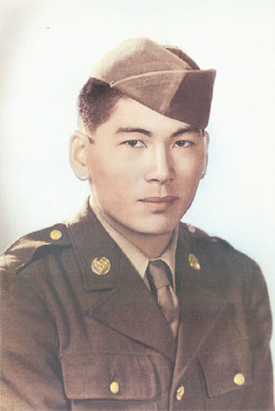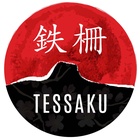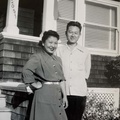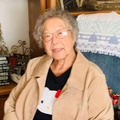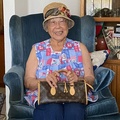Can you describe what happened when your parents found the Colorado church and were able to avoid camp?
When the evacuation order came out, Governor Ralph Carr in Colorado made a statement saying, “If Governor Warren doesn’t want you in California, you are welcome to come to my state of Colorado.” And many Japanese did. But only those who could afford to go or who weren’t afraid. Here, most of them had never left their area of California. And to go to Colorado, you know, it was very difficult. Well in my parents case, being Seventh-day Adventists, the church contacted a Seventh-day Adventist church in Delta, Colorado and asked them to sponsor a Japanese family. And they said sure. And somehow my family got picked.
So we go down on Highway 99 and some place down south by Bakersfield, my parents decide since we’re from L.A., all those people had been sent to Manzanar. So they said let’s go to Manzanar, visit our friends. We had a car and a small bobtail truck. My father drove the car and I drove the truck. We got to the gate at Manzanar and of course, the soldiers were on guard. And I had this pass. So when I showed the soldier the pass and told him what I wanted to do, he just opened the gate and we drove in.
And at the headquarters we told them, “We’re here to visit all these families. Can you get in touch with them, tell them we are here?” And they looked at us and said, “See out there? See the machine guns, the rifles, the soldiers, barbed wire fence? You’re in prison. They are not gonna let you leave prison.” So my parents said uh oh [laughs]. Maybe we’d better see if we can leave. We won’t wait. So we didn’t wait, got back to our car and went to the gate and I had this pass and pulled up there. And the same soldier that let us in is still standing there with the rifle. And I said, “We are done!” Opened the gate, and we left! So, I call it the Great Escape. Because we really got – I am sure – we were the only Japanese family in 1942 to go in a prison camp and out.
Were you shocked at seeing how it was set up with the barbed wire and the guard towers?
Not really because you know, I’m not paying much attention to detail. All of this did not sink in until 50 years later. We didn’t know that there were ten camps being built all over. We didn’t know that. Even though, like her [Lawson’s wife] father had been taken away, we didn’t know that the Department of Justice had all these other camps all over. But going back to December 7th, by four o’clock, the FBI came to our home looking for my uncle. They didn’t know that my aunt and uncle were divorced. So of course he wasn’t living with us. And they said, ”Do you know where he is?” I said, “I do.” So they said, “Will you take us there?” I said, “Sure.” So, I got into the car with the FBI and he was about thirteen miles away at the other ranch. So I took them to the ranch and when we got there, they pushed me down so nobody could see me and then they went in and got my uncle and took him out. And then they brought me home again.
Wow.
That was December 7th. Now that happened all over California. That’s how well-organized the FBI was. Now they’re saying the FBI had access to all the census records and that’s how they knew where all the Japanese were. Because they were knocking at their doors that day!
Was your uncle a minister or a language teacher?
He was a businessman. He was, what would you call it, flamboyant? In 1940 he was driving a Chrysler Airflow, which would be like a Mercedes Benz today. The car of the country. He was the head of United Farmers Association, 9th Street Produce in L.A. The Japanese owned the produce market. My father belonged to the 7th Street Flower Market. The Japanese owned the flower market. The Japanese were getting wealthy in 1940 and ’41. If the Japanese were allowed to purchase the land, they would have owned all of Monterey and Carmel because they were farming all that property.
It was this lost fortune.
You know, they talk about the millions or billions that the Japanese lost in property. It could have been tremendous because if they were allowed to buy and not just lease; they could have owned most of the land in California.
I think you are alluding to this idea already, but do you believe that Pearl Harbor was a good excuse because California farmers, the whitefarmers, were bitter against the Japanese success?
There was a lot of jealousy. They see a Japanese man driving a Chrysler Imperial and they’re driving a beat-up old Model A or something.
Right. Do you feel it was a land grab?
I think people like General DeWitt, he was so — I guess so blinded by his racism that he had the authority, militarily, on the West Coast. And all of the government was being run by people on the East Coast. Basically the WASP, white, Anglo-Saxon Protestants. Roosevelt and all of his staff, very few of them had ever seen an Asian person, very few had any contact with someone of Japanese ancestry. All they knew was that there were two Japanese foreign ministers in Washington at the time of Pearl Harbor. And what they knew was going on in China and East Asia. So when DeWitt said, “A Jap is a Jap, and will never assimilate in the Western culture. You have got to get rid of them.” “Yeah, this man must know what he’s talking about.”
It’s scary. Now, if we’re going go forward to when you were living in Colorado with your parents, can you talk about what happened when you were finally able to enlist into the army? How did you find out they made a segregated unit?
We were in Colorado I think by May of 1942. And it was in Delta, Colorado, which is a small town forty miles south of Grand Junction which is the main town of Western Colorado. And there was a Japanese farmer named Miyake and he had two or three sons. Actually one was in the army, and the older son had a photography shop in town, and the younger son was helping on the farm. And I got to be friends with the younger son and even lived out there for a few weeks, helping harvest and so forth.
During that time, I decided to go back to school, so the next year of school [I went to] Mesa College in Grand Junction. So I moved from Delta to Grand Junction and got a job as a houseboy to pay my room and board and enrolled at Mesa College. And again I was playing football and having fun. You know, kids are kids. And there was no discrimination. I got along fine with everybody there. But somehow I got word that the 442nd was being formed. And Mineko’s [Lawson’s wife] older brother was there. So we decided we’re going to join as soon as we can. So when the word came out in either February or March of 1943 that you could volunteer, we went to Denver from Grand Junction. We just hopped on the train, no tickets or anything! We got to Denver, went to the draft board, and signed up. His last name is Hirasaki, mine is Sakai. He got called in April. I didn’t get called ‘til May because it’s not just us, it’s any eligible young man.
So in the mainland, it was very slow to get boys into the 442 because they had to come from all over. Most of them from these prison camps. In Hawaii 10,000 boys volunteered immediately. And the idea was they would take 2,500 from the mainland, 1,500 from Hawaii, and form the 442. Well, they got all these boys in Hawaii willing to go. In the mainland, when the recruiters came to the camps, the boys would say, “Well, let us out of prison, let our parents out, give us our citizenship back.” “Oh, we can’t do that, but we want you in the army.” They said, “Well, screw you. We are not going in the army. Unless you let us out.”
So they had to reverse the numbers. Now it’s getting 1,500 from the mainland and 2,500 from Hawai’i. They shipped immediately a whole bunch from Hawai’i. So from the mainland, there’s 2,500 boys from Hawaii there in Camp Shelby, the mainlanders coming in one, two at a time from Arkansas, Poston, you know, from different camps. It was a long time forming.
You can understand why no one would want to volunteer. What did your parents think about you volunteering? Were they supportive?
I think my parents were different than a lot of the parents because number one, they were Seventh-day Adventists; number two, they wanted to be American. They had no intention of going back to live in Japan. And number three, their kids, like me, were American. And they expect us, if we’re going to join the army, we’re joining the American army. There were no questions. Now a lot of Japanese families in camp are very bitter and you can’t blame them. They lost everything. So when the boy says, “Dad, I think I’ll join the 442nd.” “Oh no you are not! You are not going to join the United States Army unless they let us out of prison.” That was basically what most of the Issei told them.
Quite a few of the Nisei boys had parents that said, ”This is your country. You do what you think you should do.” So you had to mix the very bitter Issei parents with the more Americanized Issei parents, and it was a very tough decision. That’s why a lot of the Nisei boys couldn’t immediately join. It took a long time, a lot of discussion and in many cases they had to leave these camps at night because normally you’d get a little ceremony or goodbye, but these pro-Japan guys would beat them up. You know, 20 or 30 of these guys coming and beating up on these kids who are volunteering. Happened a lot in camps. There were a lot of horror stories about that. We didn’t know about it but you hear about this later on. People start talking about what happened.
Now, I didn’t have to answer question 27 and 28 in camp, the loyalty questionnaire. I can understand why people would say yes/no, no/yes, no/no or yes. You know, the influence of the pro-Japan people was very strong in camp and I think they had a legitimate gripe. The country took everything away from them and put them in prison. I didn’t have that experience. But for those who did, it was a very difficult decision to join the 442. I don’t have any problem with people that said no/no. It’s just the people that were so pro-Japan, they held these rallies. “We’re gonna win the war! We’re gonna beat the United States!” They were marching with Japanese songs and, you know, those are the kind of people – and a lot of them were shipped to Japan. And almost all of them came back. And almost all of them got their citizenship back.
It’s a hard decision.
But a lot of them won’t admit to that. You know, they tell their kids, “We protested. We protested being put in prison.” But they don’t mention this pro-Japan part. And it’s a pretty touchy subject. Pretty hard to go to somebody and say, “Did your parents or grandparents ever tell you how badly you were pro-Japan?” You can’t bring up subjects like that. Of course, the Issei are all gone now. The Nisei are almost all gone. So historically the bad part is disappearing.
It’s disappearing and another generation is seeing the conflict. It’s complicated on both sides.
You know, the Japanese population is pretty much non-existent in this country anymore. As they become intermarrying with other nationalities the names change, the faces change. You just you can’t tell who’s who anymore. So the old Issei, Nisei custom is no longer in the Japanese culture.
*This article was originally published on Tessaku on April 23, 2019.
© 2019 Emiko Tsuchida


